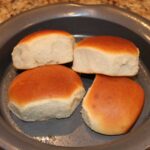
Lunch Lady Rolls
Light textured rolls that might remind you of the ones in old school lunches.
Servings 12
Cost 5
Ingredients
- 1 cup warm water 110-120 degrees
- 1 teaspoon granulated sugar
- 1 packet active dry yeast (2 ¼ teaspoons)
- 3-⅓ cups all-purpose flour (420 grams)
- 3 tablespoons plus 2 teaspoons granulated sugar
- 1 tablespoon and 1 teaspoon shortening (around 15-16 grams)
- 1 large egg, divided use. You'll see.
- 4 teaspoons milk
- 1 teaspoon salt, scant
- 4 teaspoons butter, melted (18 grams)
Instructions
- In a bowl, mix together the warm water and 1 teaspoon of the sugar. Sprinkle the yeast over the top, and let it stand for about 10 minutes, until the yeast is foamy.
- Combine just 3 cups of the flour and sugar in the bowl of a stand mixer. Cut in the shortening with a fork, your fingers or use the paddle attachment so make kind of a crumbly mixture where the shortening coats flour particles.
- Crack the egg into a small bowl or custard cup then measure out about 1 tablespoon (about a third of it, just eyeball) and add it to the bowl with the flour. Save the rest of the egg for something else such as the egg wash. Add the milk to the mixing bowl with the flour, then add the salt and the yeast water. Stir well by hand or put the bowl on the stand and mix with the paddle attachment.
- Switch to the dough hook and knead until dough appears smooth and elastic and is pulling away from the bowl. Now it's time to assess whether or not you nee dmore flour. You probably will. Add that reserved ⅓ cup gradually, kneading as you add it, until the dough is as described above (smooth, elastic and pulling away from bowl while clinging to hook).
- Scrape dough into the center of the bowl. Cover the mixing bowl with plastic wrap or a warm towel and set it aside to rise for 1 hour.
- When the dough has risen, pour the melted butter over it, return to stand mixer and knead with the dough hook for about 3 more minutes. (See Note). Dough should be smooth, elastic, slick, but not shaggy.
- Flour a large surface lightly. Let the dough rest for a few minutes, then roll or pat it out to a little less than 1 inch thick. Using a chef's knife, cut the dough into 2 inch squares. Tuck the corners of the squares under to make smooth rounds and set them in the pan (I used two 9 inch round pans with about 6 balls of dough in each. Space about 1 inch apart.
- Set pans aside for another 40 minutes rise. Preheat the oven to 400 degrees F. If you like, brush the rolls with some extra melted butter. Bake the rolls for about 12-15 minutes, until golden brown. I brushed them with a little more butter before serving.
Notes
One step I've kind of modified over the years is when adding the butter after the first rise, I just stir it a bit and then knead it by hand rather than returning to the stand mixer. The dough is squishy. Rather than roll it out, I pick up lumps a little smaller than a plum, squish them into lumpy balls and set them about an inch apart in two 9 inch round cake pans (about 7 to a pan). They look lumpy and terrible at this point, but they look pretty when they are fully risen and baked.